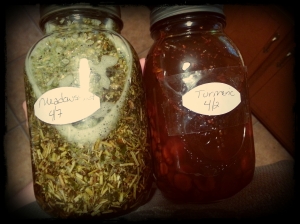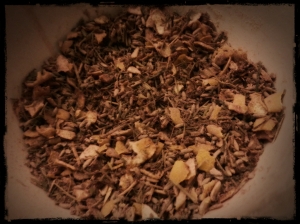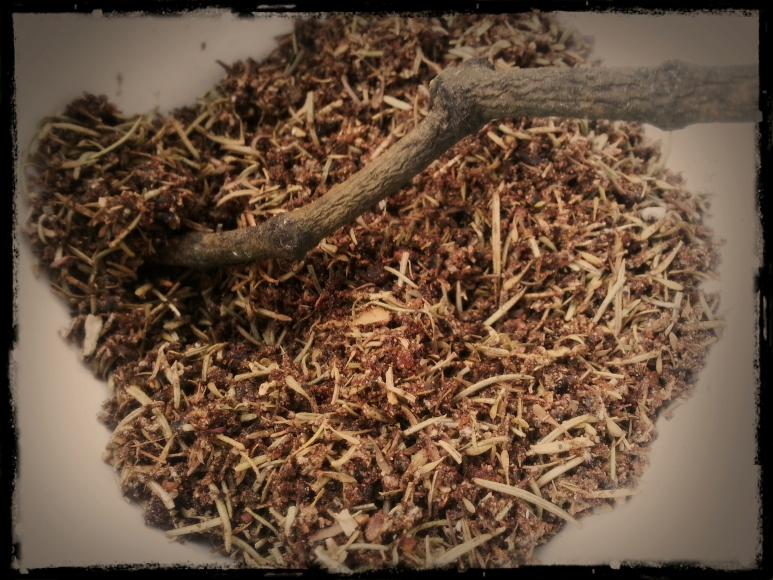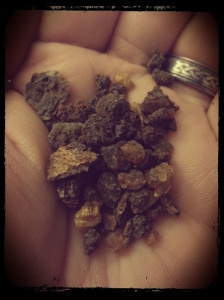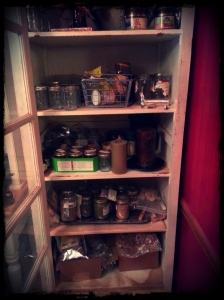Ravenson Reagents
Sensory delights for magickal seekers
Herbs for fibromyalgia (and other chronic inflammatory diseases)
My life changed about 2 years ago. I began to realize that the ‘normal’ aches and pains of being a woman in her late 30’s weren’t all that normal. A lot of other people my age weren’t feeling the same things I was. Furthermore, those ‘normal’ aches and pains were getting a lot worse. They were beginning to affect my mood, my energy level, and my ability to cope with ‘normal’ life things like stress and sleep.
I talked to a friend who has fibro, and found that a lot of my symptoms were very much like hers. So I went to a doctor, who ran blood tests to rule everything else out. She did. We were left with fibro. And here I am.
It’s been a tough road trying to learn how to manage my symptoms and keep from crashing and burning. I’ve learned that meat is bad, sleep is good. Stress is bad, hot baths are good. Sometimes I feel like I’ve gotten a handle on everything. Then I have a gnarly flare-up and all pretenses that I’m in control of my own life are shot straight to hell.
So I’ve been thinking more and more about alternative treatments, as I still don’t have insurance, and doctors and pills just aren’t in the budget. That’s how I compiled this list.
Herbs for Fibromyalgia
Pain Relief and Anti-inflammatory
- White willow bark- White willow bark has a long history of use for pain relief among Native Americans, but other varieties of willow bark have been chewed as far back as Hippocrates’ time. The main constituent is salicin, which is similar in composition to Aspirin.
- Meadowsweet- Aspirin was originally synthesized from the leaves of meadowsweet to obtain the methyl salicylic acid that we know today. It’s great to reduce fevers, pain, and the whole herb also helps to relieve stomach problems. It’s also a great anti-inflammatory.
- Turmeric- Turmeric has shown great promise in fighting the inflammation associated with osteoarthritis, rheumatoid arthritis, and other inflammatory diseases like fibro. It also covers a lot of associated problems, like headache, stomach issues (which can often arise from the medicines we take), and intestinal problems. (A lot of fibro sufferers also suffer from IBS and other intestinal issues.)
Mood Enhancement
- Kava Kava- (Sometimes called Kava) is used to help treat anxiety, stress, and sleep disorders. There is tons of information on Kava on the Internet, but it seems that a lot of it revolves on how to get the ‘high’ from ingesting concentrated doses. However, there is evidence that heavy Kava use can also cause liver damage- so tread lightly.
- Skullcap- Skullcap helps to fight anxiety and sleep problems as well. There is anecdotal evidence that shows an anti-inflammatory effect, so this may be a better option than Kava Kava all around as it doesn’t have the warnings about liver damage.
- St. John’s Wort- (Do not use with Valerian!) St. John’s Wort is best known for its anti-depressant effects. It has been used in treating chronic fatigue syndrome, fibromyalgia, and also has been shown to help with migraines. I recommend doing some research before using St. John’s Wort, however, as it does seem to interact with other drugs. There are too many interactions to list here easily.
Immune Boosters
- Echinacea- Echinacea is used to fight infections, mostly respiratory infections, chronic fatigue syndrome, migraines, and rheumatism. Generally it is used to bolster the immune system.
Miscellaneous
- Damiana- helps to recover lost libido, but is also used to combat anxiety and mild depression. It is also used as a general, good-health tonic. Sometimes, with a chronic pain condition like fibromyalgia, sexuality suffers. This can help to bring some of the spark back.
Making tinctures
I’ve ordered a lot of these herbs, and am currently waiting for them to come in the mail. However, since I already had dried meadowsweet at home, and fresh turmeric root is available at my local Asian market, I went ahead and made some. Since the turmeric root was fresh, I filled a jar with thinly sliced turmeric, and then covered with 80 proof rum. (I couldn’t find 100 proof, but this should suffice.) The meadowsweet was dried, so I 1/2 filled the jar with the herb, and then continued to fill the jar to the top with rum. I’ll leave them to soak for about 2 months, and will strain and bottle them on the full moon in June (aka The Strawberry Moon.)
Once I’m able to strain and bottle them, I’ll try each individually to see if I have any bad reactions, and then start blending them to come up with one big master mix of Fibro-banish goodness. 🙂
Ostara Celebration incense
I concocted another incense today that I’ve been noodling. It was a prime example of how the magick happens.
Ostara Celebration incense
I had envisioned (enscentioned?) the blend of lavender, violet leaf, and lemon, with something to sweeten it. Benzoin seemed like the natural compliment. However, when I began blending, the scent was nice, but it lacked a little something. I just happened to have a bag of red sandalwood here, and threw a pinch into my small sample batch. Voila! It all came together.
Lusty lavender and violet
Enlivened with lemon zest
Enriched by the vanilla sweetness of benzoin and sandalwood
Triple Goddess Offering incense
I just finished an incense that I really love. It’s a blend that just came to me easily. Some I struggle with, but this one just flowed, and I think that means something.
Triple Goddess Offering incense
Thyme for the MaidenRosemary for the Mother
Sage for the Crone
Made sacred with opoponax resin, and sweetened with rose.
This will be available for sale on our Etsy shop as soon as I can get packaging and labeling sorted. 🙂
Concocting- What to do when your sources disagree?
I’ve mentioned before that research is one of the most important parts of how I create an incense blend. But to be honest, sometimes I get stuck. Like, really stuck.
Let’s take myrrh for example. I’ve always used it to represent the feminine principle, as opposed to the sharp masculinity of frankincense. I wanted to use it as a base for my full moon incense for that reason, but I decided to go through some books and websites to see if I could confirm that that would be appropriate.
Basically, I opened a research wormhole for myself. For example, in Magical Herbalism: The Secret Craft of the Wise (Llewellyn’s Practical Magick Series), Scott Cunningham attributes myrrh to the very male Sun energies, but also to (traditionally feminine) water. In Wylundt’s Book of Incense
by Steven Smith, it is attributed to Sun and fire, both male. These books are a little older and more respected than some of the other books I have, so this is a bit troubling. I do more research. The Magick of Aromatherapy: Use of Scent for Healing Body, Mind, and Spirit
, by Gwydion O’Hara agrees with the Sun/fire correspondence, but gives a secondary correspondence of Jupiter/water. Huh?
In Magical Aromatherapy: The Power of Scent (Llewellyn’s New Age Series), Scott Cunningham changes his attribution to Saturn and water. This is getting a bit closer. Lexa Rosean also attributes it to Saturn in The Encyclopedia of Magickal Ingredients: A Wiccan Guide to Spellcasting
. Hmm.. This still just isn’t the way I tend to use it. Ah ha! In The Complete Book of Incense, Oils and Brews (Llewellyn’s Practical Magick)
, Cunningham lists it in the correspondence tables in the back under Moon. Vindication!
But wait, shouldn’t more people agree on this before I just see what I want to see? On to the Interwebz!
Oh man. Oh. Man. I don’t know why I thought to find some sort of agreement here. We’re all over the board. One thing that’s interesting, is that my favorite herbalist on YouTube, MirthAndReverence attributes myrrh with a lot of feminine qualities in this video. Ok, that’s a little more like how I’ve always used it. That feels somewhat better.
Could the discrepencies be because there are really 2 varieties of myrrh that are commonly found? There’s Commiphora Myrrha, which is your basic, garden variety myrrh. However, I’ve been using ‘sweet myrrh’, aka opoponax, which comes from Opopanax Chironium, a relative of myrrh. It’s called sweet myrrh, because it’s… well.. sweeter. Regular myrrh is more astringent in scent. Maybe this is the crux of the confusion right here!

Commiphora myrrha tree, one of the primary trees from which myrrh is harvested. (Photo credit: Wikipedia)
I can certainly understand how the more astringent myrrh could be seen as masculine, and how the gentler scent of sweet myrrh could be seen as feminine.
What it basically comes down to, then, is having a personal experience with the smoke of the sweet myrrh that I intend to use. And that’s what I did. I lit a charcoal, settled in, and lightly meditated on what I was sensing while I dropped a small nugget of sweet myrrh onto the charcoal. There is a slight astringency, but overall it seems like a kinder, gentler counterpart to frankincense. It’s a little deeper and doesn’t quite assault the nostrils so much. (I’ve never been an enormous fan of frankincense, and will only use it sparingly in my blends as it tends to completely take over.) There’s still a sense of the sacred in the scent, but it’s not so overpowering and aggressive. The scent really just FEELS right for what I’m going to be using it for. When I add in a pinch of sandalwood, which is going to be the other part of the base, I have a moment of bliss, feeling the creamy gentleness of the combined scents wash over me. A smaller pinch of mugwort, all in the name of testing, and some woodier, herbier notes emerge.
THIS! This is why I do this. I spend hours and hours trying to come up with the perfect blend, and when it goes right, it goes SO right. So that’s what it comes down to. All the research and agonizing only took me so far. What really got me to the end was CONNECTING with my ingredients. That can only be done when you go to your silent center, and question what’s right for you.
I’ll be making this blend on the next full moon, and it will be for sale at our Etsy shop shortly thereafter. 🙂
How I create my incenses (and other goodies)
So here’s the thing. I take my incense-making very seriously. I don’t just throw a bunch of stuff together and call it good. It takes me a while to develop a good recipe, and here’s why…
My process:
Step 1: Research. I spend hours poring through books and notes and websites and spreadsheets, trying to find ingredients suitable for my purposes. I don’t take this step lightly, and I try to find several sources who agree on the specific properties I’m searching for. If one website says that X is good for Y, for example, and that ingredient piques my curiosity for the blend I’m working on, I search to see if other sources agree or if I can find some historical usage that would support that property.
Then I make a list of things that may work in this particular blend.
Step 2: Inspiration. This is when I try to find that added ingredient or ingredients that will take the blend from something nice to something truly unique. This is where the magick happens. This is where I get to play mad scientist and consider using fruits, vegetables, grains, or other things that will take the blend over the top.
Step 3: Gathering. This also requires more research as I spent a lot of time trying to find not only the best sources for my ingredients, but also the most ethical and sustainable. There are a lot of ingredients (such as sandalwood and frankincense) where sustainability is a real concern. How can a blend be truly magickal if it’s bad for the earth or the plants that it came from?
I also enjoy dragging Bear out into nature whenever possible to wildcraft local herbs and resins. I always ask the permission of the plant I’m collecting from, and leave an offering in return.
Step 4: Testing. I may have what I think is the perfect blend in my mind, but this step can change everything, sending me back a few steps. For example, did you know that jasmine smells terrible when burned? Its magickal properties are very specific and desirable, but who wants an incense that smells musty and burny? This is where I test each ingredient slowly and then begin to blend them, taking careful notes the entire time.
Step 5: Finalizing. This is where I may throw in another drop of essential oil, or a little more of an ingredient that seems to blend into the background. I like to let the incense sit for a week or more before this step to let everything come together. Most of the time, the whole is more than the sum of its parts, but sometimes it needs a bit of tweaking at the very end.
Step 6: Storage. I usually store my incense for my use in whatever jar I have handy, as long as it’s airtight and glass. However, packaging has been a concern for the incense I intend to sell. Buying small jars (even wholesale) is expensive, most of the time $1 or more per jar. However, with all the care I put into making my incense, I would never feel OK about just packaging it in a cheap plastic bag with a boring label. So this is something I’m working on, and will continue to refine my packaging until I find something I love that will keep the incense beautiful and fresh for as long as possible.
***********************
This is very similar to the procedure I use for making oil blends, candles, bath salts, mojo bags, and anything else that takes my fancy. I’ve been making magickal tools for over 20 years now, and I’ve learned a lot about what NOT to do as well as the things that work. I hope you get a chance to enjoy one of my blends sometime! 🙂
Mistletoe
Perhaps the very mention of mistletoe brings up the memory of Yuletides past with stolen smooches and time with friends and family. Or, if you’re a little more mystically inclined, it might bring up visions of ancient Druids, harvesting the sacred herb carefully for ritual purposes with a clean, blessed boleen and catching it on blessed white sheets so that the power didn’t dissipate when the herb touched the ground. (Part of what makes mistletoe sacred is that it never touches the earth. It’s symbolic of air for that very reason.)
For me, mistletoe brings up a series of gathering expeditions. Some were successful. Some weren’t. Some were absolutely hilarious. When I was maybe 20 years old, and my sister was about 15, a friend and I decided to gather some mistletoe for our Yule festivities. We brought a rope with a weight on the end, hoping to throw it over branches and knock the sacred herb down, to be caught by my waiting (yet naive) sister below.
We chose a huge oak tree in front of my elementary school, and got to work. Quickly we realized that this method wasn’t going to work for us, as we tried and tried to knock some down, but to no avail. So we came up with a ‘better idea’. We convinced my (then very skinny) sister that we could tie the rope into a type of seat/harness, and then lift her up into the tree where she could easily pluck the sprays of mistletoe from the branches. We congratulated ourselves on our brilliance and got to work.
The reality wasn’t so pretty. We looped the rope over a likely branch, and tied it around sister’s hips. Then, when C and I, (both strong, large girls) tried to heft her into the tree, three things happened. First, the rope didn’t slide easily along the rough bark of the branch. So there was a lot of sweaty heaving (not the sexy kind) with no result. Second, when we finally DID manage to bring my sister off the ground, the careful knotwork we were so certain of became a slip knot, and squeezed her thighs, resulting in a very upset, crying sister. We tried to lower the rope, but again, it was stuck on the rough bark. Third, with all the flailing and crying and ‘whydidn’twebringaknife!’-ing, sister managed to turn upside down.
So there she was, hanging with her ass in the air, about a foot off the ground, crying and flailing at us while we tried A. not to laugh, and B. to figure out how to get her down. We failed miserably at A, and that was the first time I can remember laughing so hard that I actually peed.
In successive years, I’ve managed to find more success in gathering mistletoe. More than anything, I’ve learned to scout likely trees for LOW HANGING bunches, and this has made all the difference.
*******************************
Mistletoe is sacred to several dieties, including Apollo, Odin, Frigga, and the Druids, who called it ‘All Heal’. For a retelling of how the Norse god Baldur was killed using mistletoe, click here.
For our magickal purposes, mistletoe represents fertility, love, luck, healing and protection. It’s attuned to air energies as it grows seemingly in thin air, though some traditions maintain that it holds the soul of it’s resident tree. I usually work with it around Yule and Imbolc, as that’s when it’s most visible and easiest to obtain.
********************************
This year we gathered quite a lot of mistletoe, making sure to leave an offering for each tree, though since mistletoe is a parasite, it could be said that removing it is an offering itself. We brought it home, washed it, and set it out to dry. We’ll be selling it by the ounce as soon as it’s ready. 🙂
As for my share? I’ll be using it in next year’s Yule incense again, and also will place a few pinches in a protective mojo bag for myself. I may also place a dried sprig on our car’s rearview mirror for its protective properties.
Kyphi Day 6- Juniper
Juniper was actually native to a lot of areas in Egypt. Juniper, like cedar, is part of the cypress family, and its 50+ species are widely available in the Northern hemisphere. It wasn’t exotic, but it did smell great, and so it found its way into incense and perfumes.

English: Juniper berries Last year’s berries are ripe and ready for picking. This year’s berries are green and can be seen just behind. http://www.geograph.org.uk/photo/1593511 1593511 (Photo credit: Wikipedia)
The wood, needles, and berries can all be used in incense making, but for our kyphi, we’ll be using the berries. The powers of juniper are related to fire, mostly protection and healing. While researching juniper, I also found information on a fermented juniper drink called Smreka. I’m going to have to try this too. 😉
Kyphi Day 5- Cedar
We don’t think of cedar as being particularly exotic these days, but in Egypt, it was tough to come by. It was mostly imported from Byblos, a Phoenician city located in modern Lebanon, at great expense. Fortunately for us, cedar is pretty easy to find. I purchased a 2 lb bag of pet bedding for roughly $6. This is probably the least expensive of my ingredients. It’s also not endangered in any way, so no worries.
When I approached the box on my front porch, I could smell the cedar from about 5 feet away, through the cardboard and plastic bag. It’s crisp, spicy, woodsy, and wonderful. I can’t wait to use it, which is good because I have a LOT.
Cedar brings healing, purification, and prosperity. These are all good things. Its energy is masuline, and associated with the sun and fire.
Kyphi Day 4- Myrrh
FINALLY! Myrrh is not at all endangered. So I bought a LOT of it. I like myrrh quite a lot, too, because it has so many associations with feminine and lunar energies. It’s also mostly associated with the water element, and some earth. Incense-Making.com describes the scent as “deep, rich, warm, earthy, bitter, balsamic, slightly sweet and spicy, herbaceous“. Here is MirthAndReverence’s video on Day 4- Myrrh.

Myrrh was one of the luxury items that had to pass through the Nabatean territory to be traded elsewhere. (Photo credit: Wikipedia)
To be honest, I didn’t buy true myrrh. I bought something called ‘sweet myrrh’. I don’t know what I was thinking, but there was a listing for myrrh, and a listing for sweet myrrh (also called opoponax). I just chose the one called sweet myrrh and ordered a pound of it. Actually, the energies are very similar, and opoponax is a relative of true myrrh. It’s often used by people who want myrrh, but without so much of the bitterness. So I’m using this in my kyphi pretty confidently.
I couldn’t find a video on how myrrh is harvested or grown, but I did find this video on the barest basics of burning granular incense on a charcoal. I love her altar and her Hecate statue.
-
Recent Posts
Incense Making Music
Archives
Categories
Meta

